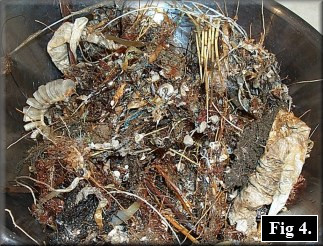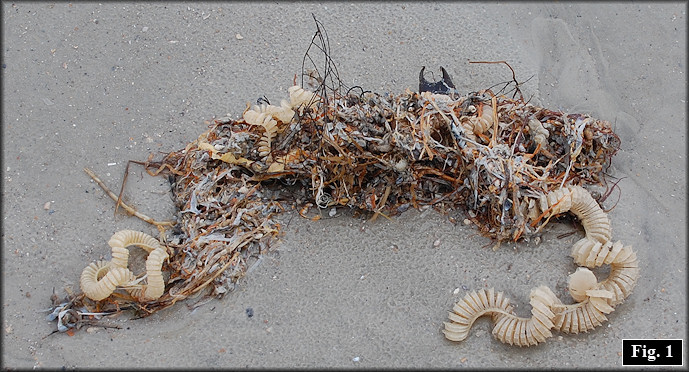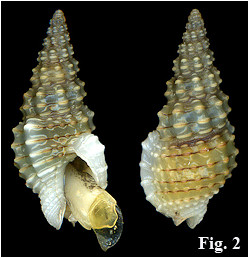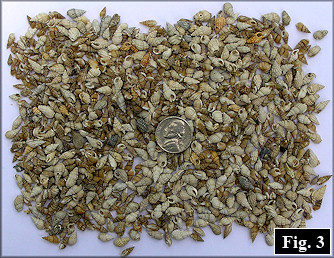Around mid-afternoon on April 6, 2008, Bill Frank was making his customary
rounds during a minus low tide at Mayport Naval
Station beach, when he noticed a larger-than-usual something-or-other in the
distance, about 25 yards south of the boulders comprising the south jetty of the
St. Johns River entry. As he approached, it became apparent that this was
not a Horse Conch or giant whelk but rather a tangle of heterogeneous marine
life (Fig. 1). On closer inspection it was found to be studded with the
shells of small mollusks, mostly hermit-crab-inhabited gastropods. By
instinct he bagged the whole thing up and stowed it in his back pack. After
toting the ”heavy mess” (Bill’s words) around for
a couple of hours and getting soaked as a consequence, he finally got back
to his car and headed home.
Knowing he had an entire shell collection in this half cubic ft. conglomeration, he asked
me to evaluate the part of the assortment comprised of
molluscan remains. We tacitly admitted a sense of déjà-vu as Brian
Lloyd had provided his mom, Charlotte Thorpe with a similar tangle eight years
earlier, and it proved to be a sheller’s
equivalent of a Vegas slot-machine jackpot (Lloyd, 2000, 2000a).
I was able to extract the mollusk shells from this mix of
algae,
sea whips, marsh grass, parchment worm casings, whelk egg cases, etc,
and here is what was there (phylogenetic
order):
|
5 |
Modiolus
squamosus
Beauperthuy, 1967 Southern
Horsemussel |
|
2 |
Lunarca
ovalis (Bruguière, 1789) Blood
Ark [one alive] |
|
21 |
Anadara
transversa (Say, 1822) Transverse Ark [19 alive] |
|
17 |
Mulinia
lateralis (Say, 1822) Dwarf
Surfclam |
|
1 |
Tellina
versicolor DeKay, 1843
Many-colored Tellin |
|
2 |
Donax
variabilis Say, 1822 Variable Coquina |
|
5 |
Abra aequalis
(Say, 1822) Atlantic Abra |
|
1 |
Crepidula
convexa
Say, 1822 Convex Slippersnail
[alive] |
|
17 |
Neverita
duplicata (Say, 1822) Shark Eye |
|
21 |
Tectonatica
pusilla (Say, 1822) Miniature
Moonsnail |
|
12 |
Epitonium
angulatum (Say, 1830) Angulate
Wentletrap |
|
2 |
Epitonium
humphreysii (Kiener,
1838) Humphreys’ Wentletrap |
|
1 |
Epitonium
multistriatum (Say, 1826) Many-ribbed
Wentletrap |
|
6 |
Gyroscala
rupicola (Kurtz, 1860) Brown-band
Wentletrap |
|
30 |
Eupleura
caudata (Say, 1822) Thick-lip Drill |
|
2 |
Stramonita
haemastoma (Linnaeus, 1767) Florida Rocksnail |
|
24 |
Urosalpinx
cinerea (Say, 1822) Atlantic Oyster Drill |
|
3 |
Gemophos
tinctus (Conrad, 1846) Tinted
Cantharus |
|
8 |
Busycon carica
(Gmelin, 1791) Knobbed Whelk |
|
3 |
Busycotypus
canaliculatus (Linnaeus, 1758) Channeled Whelk |
|
1 |
Fulguropsis spirata
(Lamarck, 1816)
Pearwhelk |
|
4
|
Ilyanassa
obsoleta (Say, 1822) Eastern
Mudsnail |
|
69 |
Ilyanassa
trivittata (Say, 1822) Threeline
Mudsnail |
|
989 |
Phrontis
acutus (Say, 1822) Sharp
Nassa |
|
2 |
Fasciolaria
hunteria (G. Perry, 1811) Eastern Banded Tulip |
|
1 |
Triplofusus
giganteus
(Kiener, 1840) Horse Conch |
|
269 |
Astyris lunata
(Say, 1826) Lunar Dovesnail [almost
all alive] |
|
14 |
Costoanachis
avara (Say, 1822) Greedy
Dovesnail [a few alive] |
|
3 |
Costoanachis
translirata (Ravenel, 1861) Well-ribbed
Dovesnail |
|
5 |
Parvanachis
obesa
(C. B. Adams, 1845) Fat Dovesnail |
|
50 |
Olivella mutica
(Say, 1822) Variable Dwarf Olive |
|
1 |
Olivella sp. aff. prefloralia
Olsson and Harbison, 1953 cf.
Rice Olivella |
|
2 |
Hastula cinerea
salleana
(Deshayes, 1859) Sallé’s
Auger |
|
1 |
Neoterebra concava (Say,
1826) Concave Auger |
|
32 |
Neoterebra
dislocata (Say, 1822) Eastern Auger |
 That’s 1625 shells of 35 species. All but two of bivalve species were
represented by single valve(s), often not fully preserved. The majority of
gastropod shells showed evidence of hermit crab occupancy, and very few
living mollusks were encountered. In both groups exceptions are noted
above. That’s 1625 shells of 35 species. All but two of bivalve species were
represented by single valve(s), often not fully preserved. The majority of
gastropod shells showed evidence of hermit crab occupancy, and very few
living mollusks were encountered. In both groups exceptions are noted
above.
Brian Lloyd’s
one cubic ft. tangle was “collected” by being foul-hooked while he was
whiting-fishing in the surf at Katherine Hanna Park, Atlantic Beach on
4/24/00. It was composed of “a discarded fishing rig entangled with algae,
dead seawhips, marsh grass, a large parchment
worm, sponges, and an empty whelk case” (Lloyd, 2000, 2000a; Fig. 4).
Although somewhat larger in volume, the tangle’s description sounds
essentially the same as Bill’s 2008 material and invites comparison. Brian’s
tangle was handed over to his mom, and I was able to identify 3952 shells of
60 species.
Brian’s top
ten species were [rank and number in Bill’s tangle]:
|
1. |
2088 |
Phrontis
acutus (Say, 1822) Sharp
Nassa [1; 989] |
|
2. |
431
|
Tectonatica
pusilla (Say, 1822) Miniature
Moonsnail [8; 21] |
|
3.
|
323 |
Parvanachis
obesa
(C. B. Adams, 1845) Fat Dovesnail
[16(tie); 5] |
|
4. |
269
|
Astyris
lunata (Say, 1826) Lunar
Dovesnail [2; 269] |
|
5. |
161 |
Terebra
dislocata (Say, 1822) Eastern Auger [6; 32]
|
|
6. |
133 |
Ilyanassa
trivittata (Say, 1822)
Threeline Mudsnail [3; 69] |
|
7. |
92 |
Olivella
mutica (Say, 1822) Variable Dwarf Olive [4;
50] |
|
8. |
51 |
Neverita
duplicata (Say, 1822) Shark Eye [11; 17] |
|
9.
|
47 |
Eupleura
caudata (Say, 1822) Thick-lip Drill [5; 30] |
|
10.
|
40 |
Acteon
candens
Rehder, 1939
Rehder’s Baby-bubble [not found] |
and
Bill’s top ten [rank and number in Brian’s tangle]:
|
1. |
989 |
Phrontis
acuta (Say, 1822) Sharp
Nassa [1; 2088 |
|
2. |
269 |
Astyris
lunata (Say, 1826) Lunar
Dovesnail [4; 269] |
|
3. |
69 |
Ilyanassa
trivittata (Say, 1822)
Threeline Mudsnail [6; 133] |
|
4.
|
50
|
Olivella mutica (Say, 1822)
Variable Dwarf Olive [7; 92] |
|
5. |
30
|
Eupleura
caudata (Say, 1822) Thick-lip Drill [9; 47]
|
|
6. |
32 |
Terebra
dislocata (Say, 1822) Eastern Auger [5; 161]
|
|
7. |
24 |
Urosalpinx
cinerea (Say, 1822) Atlantic Oyster Drill
[11; 34] |
|
8. |
21 |
Tectonatica
pusilla (Say, 1822) Miniature
Moonsnail [2; 431] |
|
9. |
21 |
Anadara
transversa (Say, 1822) Transverse Ark [15;
17] |
|
10.
|
17 |
Mulinia
lateralis (Say, 1822) Dwarf
Surfclam [17; 13] |
Why the hermit-crabs concentrated in these tangles is not clear, but
such gregarious behavior has been observed in other situations such as
among intertidal rocks in various localities.
The relative
abundance of the Sharp Nassa (Figs. 2, 3) and
the Dovesnails stands out, and, as Charlotte
indicated (Lloyd, 2000, 2000a) in the case of the Nassa
snails, this numerical dominance of members of this family (Nassariidae)
is encountered in
shallow water ecosystems of
other parts of the world. The same can be said of the
Dovesnails of many species in many disparate
geographic areas.
There are
other similarities and differences in these analyses, but the similarities
are the more striking. I think it safe to conclude that the composition of
the molluscan fauna, at least the smaller
species, on our beaches hasn’t changed appreciably over the first eight
years of this millennium.
Acknowledgements: I thank Charlotte Thorpe for Fig. 4 and Bill Frank for
Figs. 1, 2 and 3.
Lloyd, C.,
2000. A remarkable catch. Shell-O-Gram 41(4):
1, 3-5. July-August.
Lloyd, C.,
2000a. A remarkable catch. American
Conchologist 28(3): 4, 24. Sept.
|



